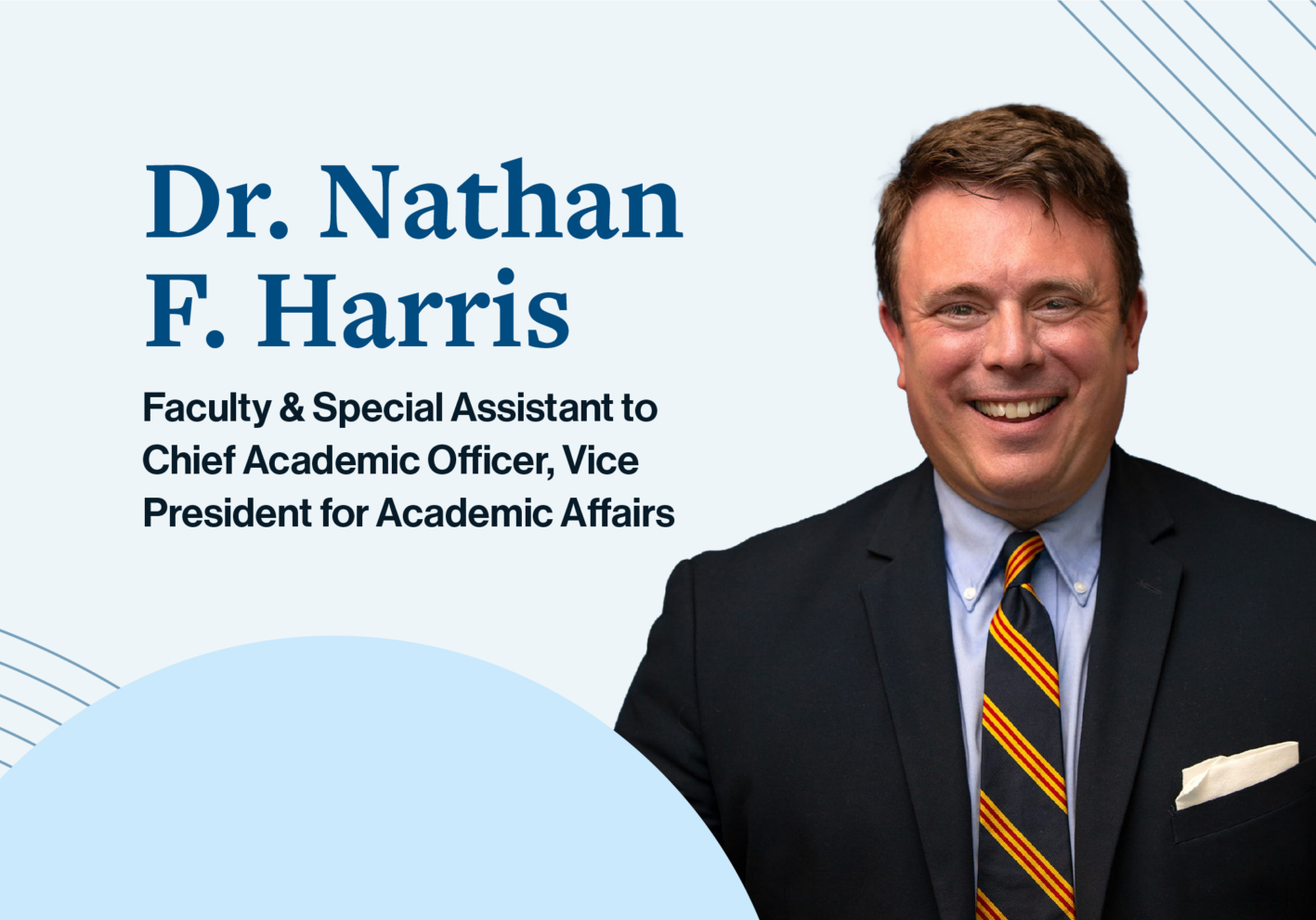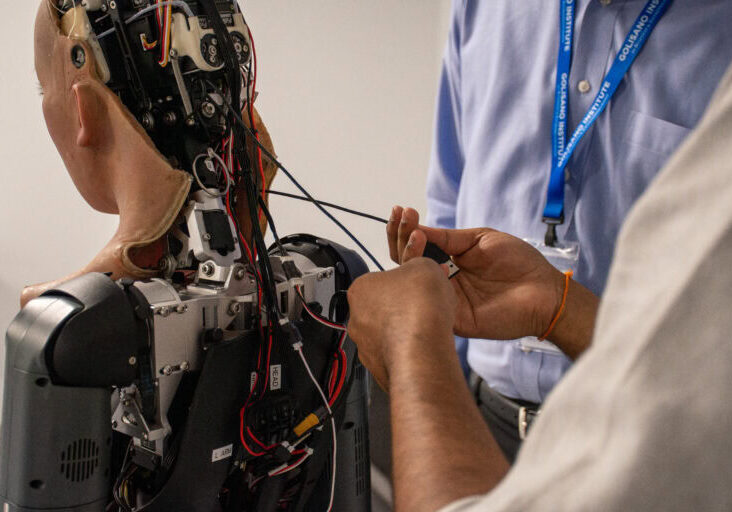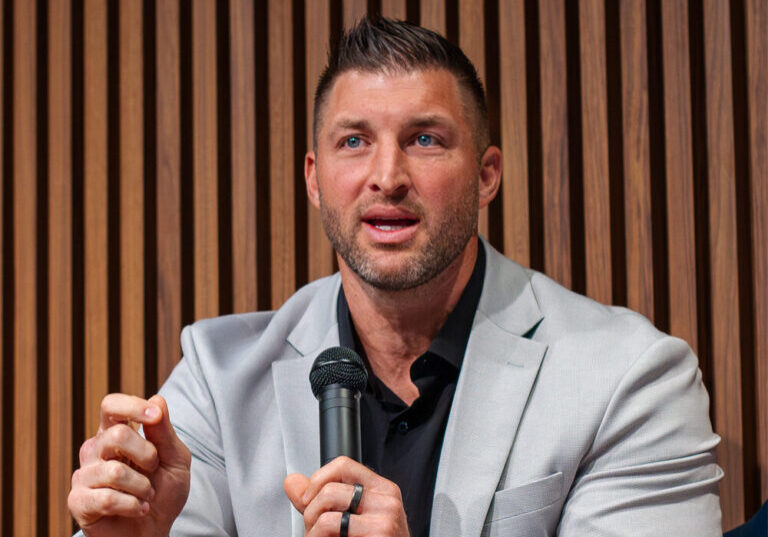1. Describe your role as a faculty member, Vice President for Academic Affairs, and Special Assistant to the Chief Academic Officer.
The day is always busy! An entrepreneurial spirit anchors our work here. In Academic Affairs, you can feel it while we collaborate to design curriculum, develop and implement policies, teach classes, and mentor students. We are questioning assumptions about teaching and curriculum, experimenting with new approaches to learning and development inside and outside of the classroom, and forging a dynamic form of higher education that accelerates student learning, which helps students start or expand businesses, kickstart careers in business, or pursue bachelor’s degrees.
In terms of routine, my days often involve teaching classes in the morning and attending meetings in the afternoon. I meet with students during office hours, reinforcing key concepts from class and advising them on a host of issues, and I also prepare for upcoming classes, including grading assignments. I attend meetings most afternoons, including convening weekly meetings with the lead instructors for each of our cohorts or attending a weekly Academic Affairs Leadership team meeting convened by Dr. Scott Baker, the Institute’s Chief Academic Officer.
My hybrid role – part faculty, part special assistant in Academic Affairs, part evangelist for teaching and learning, part researcher for the Institute – also means that my “routine” schedule often changes. By wearing multiple hats, I develop a holistic perspective on the Institute’s mission and operations. Every day is an adventure! All this work presents a once-in-a-lifetime opportunity. I am privileged to work with amazing students and colleagues who are all committed to making Mr. Golisano’s vision come to fruition.
2. What motivated you to transition from your previous role and join Golisano Institute as a Faculty member?
My move to Golisano Institute was motivated by several professional reflections. First, I wanted to return to teaching undergraduate students in some fashion. During my time as a PhD student, I enjoyed working as a graduate student instructor in an Organizational Studies program. The undergraduate experience is transformational because students grow so much, including learning about life possibilities that they did not even know existed before college. This context presents a rich backdrop for teaching and mentoring: as a teacher, explaining and even evangelizing certain ideas and concepts, and as a mentor, asking students questions about their hopes and dreams and then tailoring advice about career pathways to consider. The impact of this work was further underscored while teaching incoming students at a collegiate Summer Bridge program for three summers. As my career progressed, I found myself missing those interactions and that form of collaborating, even while working with incredible colleagues and graduate students at the University of Rochester.
Second, my own experiences with university service and my interest in considering the benefits of working in a more hybrid role within higher education. University service applied my knowledge about higher education governance and organizational studies while also drawing on previous work experience as a management consultant. In my mind and in conversations with my wife, Jennifer, I began crafting a position that was part teacher, part administrator, part researcher, and part organizational consultant. I knew that this sort of role was uncommon. Amazingly, right as I was forming these visions, Golisano Institute was launched, and the Institute’s President, Ian Mortimer, and the Institute’s Chief Academic Officer, Scott Baker, were looking for someone like me to fill that sort of role.
Third, the unique opportunity to help launch a new higher education institution was very appealing. In higher education, you work in organizations with longstanding policies and norms. Newcomers to colleges and universities often ask, “Why do we do this?” or “Why do we do that?” and the answer tends to be, “Well, that’s how we’ve always done it.” Longevity can be a strength because it reflects durability, but it also becomes a liability because it can impede innovation and change. The chance to join Golisano Institute felt like a once-in-a-lifetime opportunity.
3. What courses are you currently teaching, and what can students expect from taking a course with you?
We have a cohort model at Golisano Institute. New students enroll in September, and another cohort enrolls in February. With each cohort, our course sections include no more than 24 students. We co-teach most of our courses, so the student-to-teacher ratio is less than 12:1 in most courses. This practice allows us to create a dynamic learning environment in which students can learn more concepts more quickly.
Within this framework, instructors serve either as lead instructors or co-instructors. This quarter, I am the lead instructor for the Managerial Economics course, which I taught with our inaugural cohort in fall 2023 and then again, this past summer. This course, which I am co-teaching with Michelle Staebell and Samuel Noel, explores foundational economic concepts such as the macroeconomic environment, market demand and supply, production and cost function, and pricing. Last quarter, I was a co-instructor in Business Math (with Dylan Burrows) and our introductory Career Development course (with Chris O’Connor). Later this year, along with Scott Baker, our Chief Academic Officer, I will be designing the Organizational Behavior & Leadership course as lead instructor.
With co-instructors (like Dylan Burrows in economics), I try to create a rich, intense, and fun learning environment. In my classes, we work hard but also laugh, which is how I approach work. We take the work very seriously, but without taking ourselves too seriously. My teaching approach emphasizes active, experiential learning. By analyzing real-world case studies and business scenarios in groups, students develop their technical business skills and entrepreneurial capabilities, “soft” skills such as collaboration and interpersonal communication, and analytical skills such as critical thinking and problem-solving.
I expect students to prepare for class – read the textbook or watch assigned videos and then complete pre-class quizzes – and be ready to learn from their peers in groups. But I don’t expect immediate understanding. Most concepts and ideas take time to learn. As a student, I rarely understood a concept or an idea after reading it once or twice, even three times. So, as an instructor, I appreciate that learning can be frustrating, even deflating. My classroom can feel like a lab where students learn by practicing their business skills while also pushing themselves to redefine their limits and enrich their capacity to eventually make more complex decisions as entrepreneurs and future managers.
4. One of the many things that makes us special is the 60/40 teaching/mentoring split for faculty. In what ways do you and your colleagues mentor students beyond the classroom to help them navigate their career paths?
Yes, we aim to mentor students beyond the classroom, adopting a more holistic approach. Between morning classes, and during afternoon office hours, discussions with students explore not only their specific questions about coursework, which accelerates their learning, but also their personal and professional aspirations. Like many people, students will tell their stories if they feel like you really care and want to learn about them as people. With this knowledge – or understanding– instructors can help students make sense of their interests and strengths, connecting coursework to future career possibilities and offering richer guidance because we know students as people. With this familiarity, we also help students explore how they might overcome potential barriers or hurdles that could complicate or derail their ambitions. As we get to know students, we can better assist them in ways that enhance their learning and development inside and outside of the classroom.
I have seen how my advice can influence student decisions, ranging from developing or expanding their businesses to discovering potential internships to coaching through workplace dilemmas. These discussions sometimes take the form of scheduled meetings but more often occur organically, which reinforces an institutional culture that prioritizes mentorship inside and outside of the classroom.
5. With the rapid changes in the business landscape, what key skills do you believe future business leaders should prioritize in their education, and how does this inform your curriculum design?
I love this question because it attracts tremendous attention from the business press, prognosticators, and consultants. It is an enduring question; every few years, we learn about a new set of recommended skills for business graduates.
Our accelerated curriculum, which spans eight quarters over two years, features core business skills such as accounting, finance, and marketing and unique features such as a sequence of entrepreneurship courses over the first three quarters, career development courses and internships over most quarters, two courses on developing sales skills and strategies, a sequence of three business analytics courses, and the weekly speaker series, Speaking from Experience, which features talks with prominent entrepreneurs and executives.
We recognize that our curriculum, even with its rigorous foundations and exciting differentiators, requires a complementary set of practices and policies that socialize professional attitudes to transform how students think, act, and lead. Our practices include a student dress code, which differentiates between appropriate business attire for attending class versus attending talks and networking events. We often hear from employer partners they seek employees who demonstrate enduring workplace norms – arriving on time, dressing ready to work, paying attention to customers and colleagues, asking questions to better understand problems, and taking pride and ownership in work.
Every day, we clarify the right recipe for required business skills and professional attitudes, which then enables us to adapt our curriculum, practices, and policies. In terms of emerging skills or skills for the future, I suspect that we will continue emphasizing a combination of a) core analytical capabilities associated with adaption, innovation, and entrepreneurship, such as critical thinking, problem-solving, and strategic analysis, b) “soft” skills such as interpersonal communication, emotional intelligence, ethical reasoning, and cultural awareness, and c) technical skills such as digital literacy, especially data analytics and integrating AI applications into decision-making, and organizational behavior and leadership.
6. What advice would you give to a prospective student who wants to enroll at Golisano Institute?
For starters, come visit us! Seeing is believing when selecting a college. When prospective students visit our campus center, they experience firsthand the welcoming and close-knit culture among students and between students and staff. Immediately, they realize that peers and staff take an interest in you and want to learn about your interests. Who are you? Where are you from? What do you want to become? In and out of class, applicants see that students work hard but also have fun. Applicants often see some of themselves in different students that they meet – maybe it is similar backgrounds, similar career ambitions, or similar rationales for pursuing a new form of college. When describing their experiences at the Institute so far, current students represent the Institute as authentic ambassadors and enthusiastic recruiters.
During visits, prospective applicants also immediately sense our focus on business and entrepreneurship as well as grasp the real-world experience and expertise of our staff and faculty. For all these reasons, most applicants who visit our campus center ultimately enroll at Golisano Institute.
I would also encourage prospective applicants to visit the Institute’s website and follow the Institute on social media. Our marketing team designs and generates amazing content that richly captures the breadth and depth of Golisano Institute’s offerings and emerging national profile, including the student experience inside and outside of the classroom. These media sources illustrate and animate the bountiful opportunities available to students.
Share this article
Related Articles
“The opportunity is out there. You just have to find it.”
Tom Golisano, Founder


